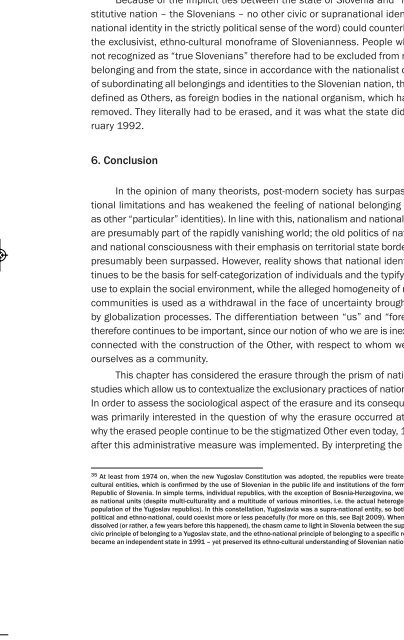The Scars of the Erasure_web
The Scars of the Erasure_web
The Scars of the Erasure_web
- No tags were found...
You also want an ePaper? Increase the reach of your titles
YUMPU automatically turns print PDFs into web optimized ePapers that Google loves.
<strong>Erasure</strong>_4a 10.1.11 20:29 Page 213MORE THAN ADMINISTRATIVELY CREATED “FOREIGNERS”213o<strong>the</strong>rs, had already been firmly in place when Slovenia became independent.For <strong>the</strong> majority <strong>of</strong> <strong>the</strong> latter, “becoming convinced” that <strong>the</strong>y were in fact Slovenians– ra<strong>the</strong>r than Croats, Serbs, etc. – was out <strong>of</strong> <strong>the</strong> question, but more importantly,<strong>the</strong> Slovenians also no longer saw <strong>the</strong>m as “compatriots.” 35Because <strong>of</strong> <strong>the</strong> implicit ties between <strong>the</strong> state <strong>of</strong> Slovenia and “its” constitutivenation – <strong>the</strong> Slovenians – no o<strong>the</strong>r civic or supranational identity (i.e.national identity in <strong>the</strong> strictly political sense <strong>of</strong> <strong>the</strong> word) could counterbalance<strong>the</strong> exclusivist, ethno-cultural mon<strong>of</strong>rame <strong>of</strong> Slovenianness. People who werenot re cognized as “true Slovenians” <strong>the</strong>refore had to be excluded from nationalbelonging and from <strong>the</strong> state, since in accordance with <strong>the</strong> nationalist doctrine<strong>of</strong> subordinating all belongings and identities to <strong>the</strong> Slovenian nation, <strong>the</strong>y weredefined as O<strong>the</strong>rs, as foreign bodies in <strong>the</strong> national organism, which had to beremoved. <strong>The</strong>y literally had to be erased, and it was what <strong>the</strong> state did in February1992.6. ConclusionIn <strong>the</strong> opinion <strong>of</strong> many <strong>the</strong>orists, post-modern society has surpassed nationallimitations and has weakened <strong>the</strong> feeling <strong>of</strong> national belonging (as wellas o<strong>the</strong>r “particular” identities). In line with this, nationalism and national identityare presumably part <strong>of</strong> <strong>the</strong> rapidly vanishing world; <strong>the</strong> old politics <strong>of</strong> nationalityand national consciousness with <strong>the</strong>ir emphasis on territorial state borders havepresumably been surpassed. However, reality shows that national identity continuesto be <strong>the</strong> basis for self-categorization <strong>of</strong> individuals and <strong>the</strong> typifying <strong>the</strong>yuse to explain <strong>the</strong> social environment, while <strong>the</strong> alleged homogeneity <strong>of</strong> nationalcommunities is used as a withdrawal in <strong>the</strong> face <strong>of</strong> uncertainty brought aboutby globalization processes. <strong>The</strong> differentiation between “us” and “foreigners”<strong>the</strong>refore continues to be important, since our notion <strong>of</strong> who we are is inextricablyconnected with <strong>the</strong> construction <strong>of</strong> <strong>the</strong> O<strong>the</strong>r, with respect to whom we defineourselves as a community.This chapter has considered <strong>the</strong> erasure through <strong>the</strong> prism <strong>of</strong> nationalismstudies which allow us to contextualize <strong>the</strong> exclusionary practices <strong>of</strong> nation-states.In order to assess <strong>the</strong> sociological aspect <strong>of</strong> <strong>the</strong> erasure and its consequences, Iwas primarily interested in <strong>the</strong> question <strong>of</strong> why <strong>the</strong> erasure occurred at all andwhy <strong>the</strong> erased people continue to be <strong>the</strong> stigmatized O<strong>the</strong>r even today, 18 yearsafter this administrative measure was implemented. By interpreting <strong>the</strong> erasure35 At least from 1974 on, when <strong>the</strong> new Yugoslav Constitution was adopted, <strong>the</strong> republics were treated as ethnoculturalentities, which is confirmed by <strong>the</strong> use <strong>of</strong> Slovenian in <strong>the</strong> public life and institutions <strong>of</strong> <strong>the</strong> former socialistRepublic <strong>of</strong> Slovenia. In simple terms, individual republics, with <strong>the</strong> exception <strong>of</strong> Bosnia-Herzegovina, were regardedas national units (despite multi-culturality and a multitude <strong>of</strong> various minorities, i.e. <strong>the</strong> actual heterogeneity <strong>of</strong> <strong>the</strong>population <strong>of</strong> <strong>the</strong> Yugoslav republics). In this constellation, Yugoslavia was a supra-national entity, so both identities,political and ethno-national, could coexist more or less peacefully (for more on this, see Bajt 2009). When Yugoslaviadissolved (or ra<strong>the</strong>r, a few years before this happened), <strong>the</strong> chasm came to light in Slovenia between <strong>the</strong> supra-national,civic principle <strong>of</strong> belonging to a Yugoslav state, and <strong>the</strong> ethno-national principle <strong>of</strong> belonging to a specific republic thatbecame an independent state in 1991 – yet preserved its ethno-cultural understanding <strong>of</strong> Slovenian national identity.


